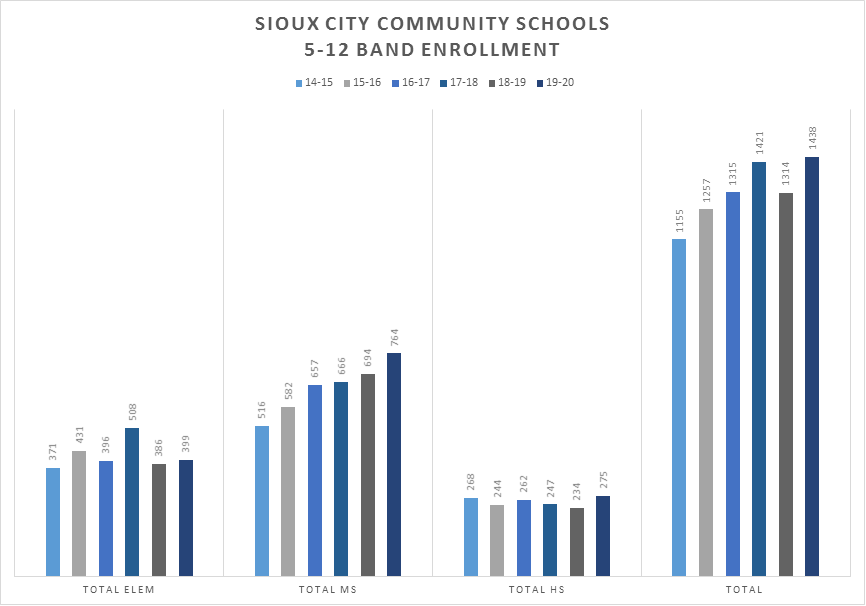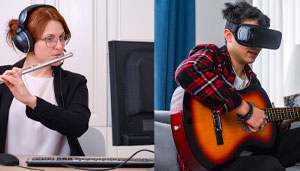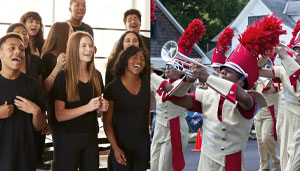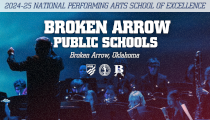“Music for all, and all for music” is a goal that all music educators strive for, but unfortunately, access to music in schools isn’t a guarantee. Zip codes should not define a child’s education, but the grim reality is that demographics are changing in our country and schools. More schools have growing rates of students eligible for the Free and Reduced Lunch (FRL) program — a federal measure of poverty. This statistic often comes with unintended barriers, such as limited access to participation in music education. However, dedicated music teachers continue to find paths for students to be successful through the universal language of music, but in order to do this, funding is needed, which is why grant writing has become increasingly vital if the “music for all” mantra is to be realized.
STEP 1: TELL YOUR STORY WITH DATA
Applying for grants is a long process, and we begin by compiling data and creating our narrative. The Sioux City Community School District (SCCSD) is an urban public school district located at the intersection of Iowa, Nebraska and South Dakota. As of October 2019, the SCCSD had a total enrollment of 14,274 students who attended 20 academic learning centers spread across the city. There are 6,656 students enrolled across 14 elementary schools, 3,356 students enrolled across three middle schools, and 4,262 students enrolled across three high schools. Ten of the 14 elementary schools and two of the three middle schools are identified as Title I schools.
Beginning in 2018, SCCSD became a majority-minority district (where the majority of the student body is nonwhite), serving students of high poverty with an average of 65% to 70% of students receiving FRL. Our student body is 35% Hispanic, 8% Black, 6% Two or more races, 3% Asian, 3% Native American, 1% Pacific Islander (combined 55%) and 45% White.One in five students is learning English as a second language. Every year, there are typically between 375 and 450 students who identify as homeless or in foster care.
Despite the fact that SCCSD is one of the poorest assessed-property-tax-per-student school districts in Iowa, we are proud of our kids and proud of the work our teams are doing to reach and help students of poverty. Our team has worked to decrease barriers and increase overall student enrollment in our performing ensembles (band, choir, orchestra) by 25% in grades 4 to 12 since October 2014. This increase highlights the incredible need for student access to district-owned instruments.
We use our data and our story to find grants to provide students with the opportunity to create, practice and perform music on quality instruments. Each SCCSD high school student is required to earn two fine arts credits for graduation. Unfortunately, the lack of access to instruments drives some students to take other fine arts electives (art, theater, music appreciation) when they might prefer music.
Our team worked to compile music-specific data for our grant applications.Data points include:
- District data as noted in our story above.
- Trends in participation over the past six years by building and by ensemble, including the number, percentage and demographics of students involved in each ensemble by grade level.
- Instrument inventory and repair reports.
- Number of instruments and type checked in/out to students each year by building (all of our instruments are bar-coded and in our district assets management system).
Prior to bar coding our instruments, our local music dealer — along with a trained repair technician and two representatives from Yamaha (one regional and one national) — came to help provide an analysis of our instruments. We spent a week going through every instrument in the district and identified each as usable (green tape), usable with repair (yellow tape) or not usable/not repairable (red tape).
After looking at our trends in participation and our district inventory, our team built the first of many five-year plans for instrument replacement and additional needs.
With help from our local music dealer, we identified instrument brands/models to be purchased district-wide for uniformity, consistency and, most importantly, durability. With 25% growth in our performing ensembles as well as the shift in demographics, our five-year plan has recommended purchases between $175,000 and $250,000. This plan originally included flutes, clarinets, alto saxophones, trumpets, trombones, violins and violas; however, due to the overall cost of the request, these instruments were tabled until the following five-year plan. In looking at inventory, it was critical to purchase instruments that would help balance our bands and orchestras.
Our district is able to provide in-kind resources such as certified music educators, curriculum resources aligned to the National Core Arts Standards, dedicated classrooms, instrument storage, repair and supply budgets, music storage, music stands and chairs, computers and instruments. However, funding still remains a challenge because our community is one of the property poorest districts in the state.
Pulling together all this data helped us formulate our story as we began to look for funding to provide music-making opportunities for all of our students and support the great work of our educators.
STEP 2: LOOK FOR APPROPRIATE GRANTS
Once we compiled the data, we knew we had a compelling story to tell. Our story has helped us search for and prioritize grants that align with our goals for SCCSD students and music programs, our strategies to measure our successes, and our overall budget (that includes in-kind items).
There is no set way to seek out grants. The search for funding is limitless — it can start by word of mouth, from corporate employees with foundations, from gift matches, through internet searches or from donations. Sometimes the search for grants is narrow to specific buildings in the district. At other times, the search is wide and looks through a district lens. Because we have already collected and analyzed the data, we are able to look at available grants and select the right data points for a specific building, multiple buildings or the entire district.
The process of finding grants that match your story can be as simple as a stroke of luck, or it can be a tedious and time-consuming process. Through conversations with other districts’ fine arts coordinators and representatives from instrument manufacturers, we have learned about many national grants that we are now exploring. We have also researched large companies with charitable foundations or arms to see if they are supporting music education.
Social media has also had an impact. The #musedchat group on Twitter has put us in touch with a large network of educators, school districts and companies. Staying up to date on research and related readings has sparked ideas and opportunities to think outside the box in terms of how to frame a story in a way that will capture the attention of grant funders. When grant opportunities are found, we compare the ask of the grant to our needs, purpose and priorities. With smaller-scope projects, we spend time looking locally for funding. Energy companies, banks, arts councils, etc. often provide these types of grant opportunities.
Using our data and story this past year, we showed a need within our district, which helped with conversations at budget time. In addition to an increased budget at the district level, we applied for and were awarded several grants at the local and national levels. We received grants from the Manilow Music Project ($20,000), Country Music Association Foundation ($20,000) and our local Gilchrist Foundation ($30,000).
STEP 3: ORGANIZE YOUR INFORMATION
- Know and understand your board policy as it relates to grant writing. For example, the SCCSD Grant Application Policy states, “It is the philosophy of the Sioux City Community School District to encourage the administration to seek and apply for state, federal, or privately funded grants. Grant applications should assist the District in advancing specific goals or objectives in line with the mission established by the Board of Education.”
- Know your data.
- Know your story.
- Know your purpose or your “why.” For example, if the grant is funded, what investments will have the most impact for your overall program? If the grant is funded, but at a lower level than you requested, what will be your focus?
- Have a budget proposal ready to go and ensure that it is aligned to your five-year plan. We worked with our local music dealer to create an editable Excel sheet (instrument/make/model/price) of all the instruments on our five-year plan. The file includes the number of specific instruments needed and a final price. This allows us to tailor the ask to the limitations of the grant. This budget also includes in-kind items.
- Know what you are writing for and what the reporting expectations are in relation to the amount of the grant.
- Understand if the instruments will be purchased for you or if you can use a local dealer.
- Prepare a boiler plate with your demographic information, your “why,” and the impact the funding will have on your students, staff and community. Have this ready in case there is a short window of time to write and apply for the grant.
- Send a letter of intent to local and national companies and foundations to see if they are looking to support an arts initiative. Be sure to include your story, your data, the lasting impact funding will have on students and the community, the impact the support will have on the company/foundation itself, and your contact information for any questions.
- Print out or save the grant application to a working file so that you can edit or copy and paste into the application. Use the information that you have prepared on your boiler plate and edit it to address the questions on the application. This document is extremely practical because sometimes applications cannot be accessed once they are submitted.
- Know and observe your deadlines. Don’t wait until the last minute to submit your grant.
- If you find a grant and the deadline has passed, put a notice in your calendar to alert you when the application process reopens. This is generally quarterly or yearly.
PEOPLE WHO CAN HELP
Here are some key stakeholders to reach out to as you begin to seek out grants.
- District administration for acknowledgement and approval to apply for the grant. Make sure to follow board policy on grant writing if there is one.
- District office personnel who can provide needed data.
- Proofreader who can double check your language and data.
- Parents, community and business leaders who may know of opportunities for funding.
- School/district foundations are great resources for writing grants. They understand the nonprofit-to-nonprofit business lingo.
AFTER YOU RECEIVE A GRANT
- Know what the grant reporting metrics are in regard to expenditures, use of equipment and other requirements outlined in the grant.
- Keep accurate records.
- Talk to the finance department and find out where the money will be deposited. Also ask about the purchasing process: what paperwork is needed within the district and what approvals are needed.
- How will instruments be added to inventory?
- What receipts are needed for reporting metrics?
- What other records are specified by the grant?
- Know the guidelines of the grant — e.g., are you able to promote on the school’s website and social media? The more you can promote the items purchased with grant funds, the better. This helps tell the story for future opportunities.
- Show appreciation by sending thank you letters upon receipt of the grant to everyone associated with it. Make sure to write these letters on official letterhead. Another option is filming and sending a video that shows students using the purchased instruments.
- Stick to hard deadlines and dates as noted on the grants.
Everyone has a story to tell. Your success in grant writing will be determined by how well you align and organize your narrative, data and the lasting impact the funding will have on students and the community. When it comes to grant writing and soliciting grant invitations, you are limited only by your district board policies and your imagination.
The Sioux City Public Schools Foundation started an endowment for SCCSD music programs and has secured funding from individual local donors. In addition to all of the above resources, the endowment provides a yearly payback for instrument purchases as well.
I wish you the best as you begin your grant-writing adventure
Patricia Toben
This article first appeared on the YamahaEducatorSuite blog site. Yamaha is an active advocate for music education and empowers music educators to strengthen and improve their programs in innovative ways. Please register for the Yamaha Educator newsletter to learn more about our advocacy efforts, professional development, information about instruments, resources, partnerships in education and more. Join the Yamaha Music Educator Community on Facebook or email us at [email protected].
Most Recent Articles








